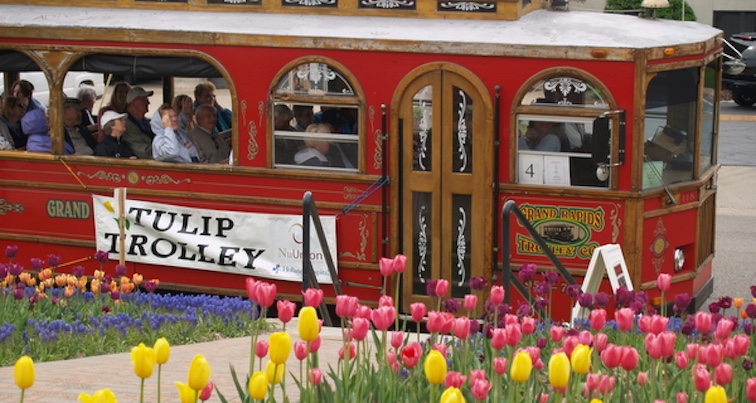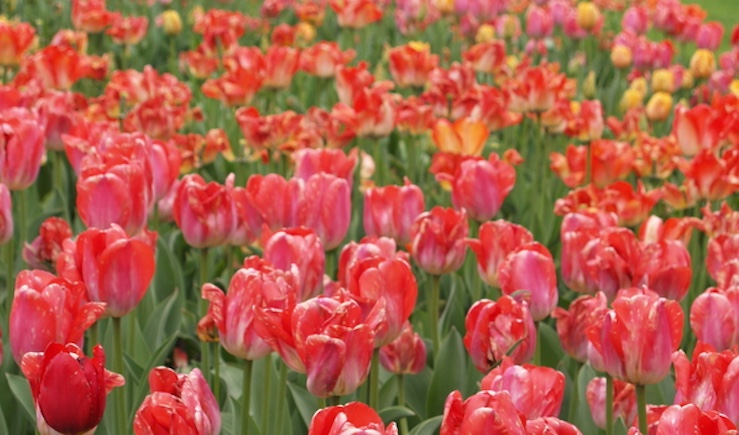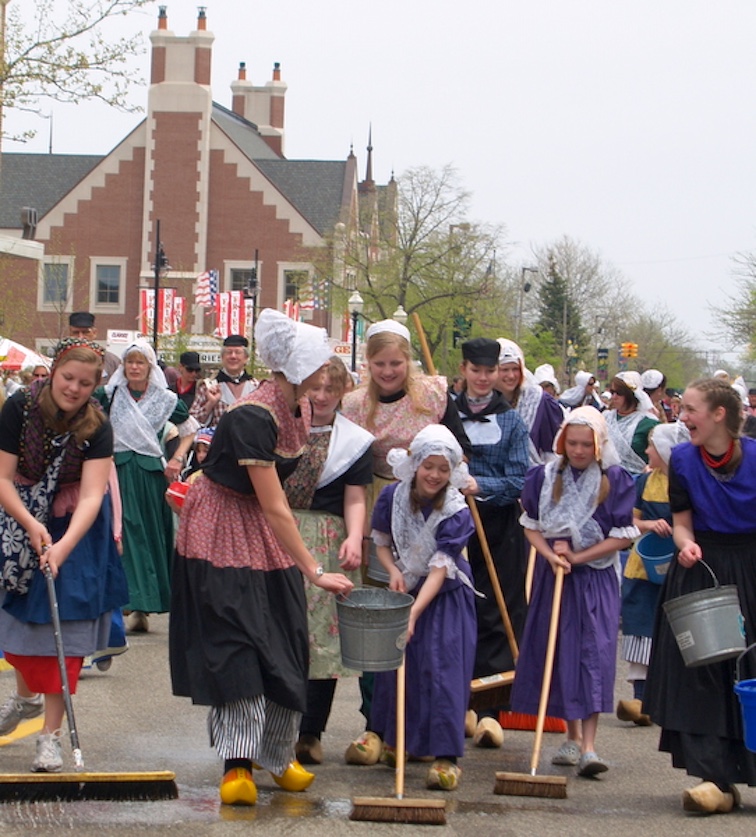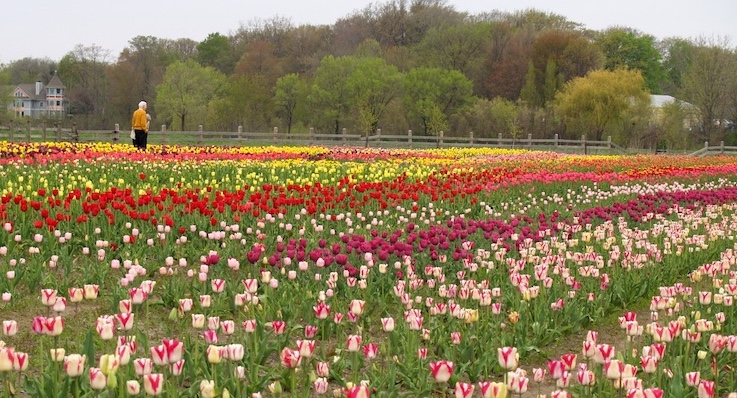
Holland, Michigan’s Tulip Trolley starts showing tourists the town every May at the start of the tulip festival. Photo by Yvonne Horn
Ah, to be in Holland when tulips burst into flower-—Holland, Michigan, that is. In Holland, Michigan, that would be the first week in May, when the entire community and thousands of visitors turn out to immerse themselves in bloemen abundance. Tulip Time. So it has been since 1929.
Given such longevity, Holland has its tulips down pat. Drive into town on River Street from US 31, and tulips in median strips and at the roadsides begin to tease the eye, the first of more than five million bulbs that burst into full bloom along streets and parks and seemingly anywhere else with room for a swath or two. Some 500,000 people each year swarm into the small Michigan town (population 35,000) to overdose not only on the abundance of the colorful tulip displays but also on its accompanying “Dutchness.”
Important to note is that Holland’s “Dutchness” doesn’t suddenly jump into existence each May. The town, year-round, boasts the only Delftware factory in the United States, along with a wooden shoe manufacturer, a working windmill, and bakkerijs serving up the likes of saucijenbroodjes (pig-in-a-blanket) and speculassje (spiced cookies).

Tulips cover Holland, MI, during the month of May. Photo by Yvonne Horn
One might also suspect that this little community located on Lake Macatawa near the eastern shore of Lake Michigan blundered into a good tourist thing in 1929 and jumped on the bandwagon with, “Hey, let’s call ourselves Holland and capitalize on this tulip thing.” But that is not so.
When Albertus Van Raalte and his 60 followers in 1847 established a community as a refuge for those seeking religious freedom, they named it in honor of their homeland—Holland. Dutch immigrants followed, carving a community reminiscent of the land they left behind out of deep forest and insect-infested swamp.
Nearly 100 years later, Miss Lida Rogers, a biology teacher at Holland High School and a member of the Woman’s Literary Club, suggested that the town adopt the tulip as its official flower and celebrate it with a festival. Tulip bulbs were purchased from the Netherlands, with residents encouraged to buy bulbs at a penny each. The following spring, thousands of tulips bloomed. Tulip Time was born. By the mid-1930s, it was nationally known.

Holland, MI residents scrub the streets in preparation for Tulip Time. Photo by Yvonne Horn
Today, a full lineup of Tulip Time festivities fills the festival week, now stretched into ten days. Hundreds of townspeople turn out in authentic Dutch costumes to march in the kick-off Volksparade, the first of a series of parades. In the tradition of Dutch cleanliness, the parade begins with the scrubbing of the street. Buckets of water are sloshed, brooms are pushed, and when all is deemed in order, the parade of tulip-bedecked floats and school marching bands begins.
Tulip mania Michigan-style continues with a Tulip Trolley trundling through tulip-lined streets to deliver visitors to tulip-filled parks. Some 800 dancers in wooden shoes and traditional costumes, representing dozens of klompen groups, gather for a competitive klompen extravaganza in the town center’s Centennial Park, where there are plentiful plantings of tulips.
The Holland Area Arts Council displays a collection of past Tulip Time posters, along with the tulip-inspired work of local and regional artists competing to be the poster creator for the following year’s Tulip Time.
On Windmill Island, a 36-acre municipal park on a canal that is part of Lake Macatawa, some 100,000 tulips lead up to the 1884-built De Zwaan windmill. Shipped in pieces from the Netherlands in 1964 and reassembled, it is the only authentic working windmill in the United States. For 20 years, Alisa Crawford, the first Dutch-certified woman miller in America and one of only five female master millers in the world, operated the mammoth sails. She now trains and oversees a team of volunteers.

The De Zwaan windmill on Lake Macatawa’s Windmill Island is the only fully functioning windmill in the U.S. Photo by Olivia Gardella
Acres of tulips scorch the eye at Veldheer Tulip Farm. Begun as a hobby farm in 1950 with the planting of 100 red and 100 white tulips, it has metamorphosed into a 30-acre rainbow of upside-down ballerina skirts representing 125 varieties, along with an array of daffodils, hyacinths, and crocus. Bulbs are available for sale in the garden shop for visitors hankering to carry a bit of Tulip Time home.
Want to photograph tulips close up but tired of all that bending down? Walk among a series of eye-level raised beds at the Tulip Immersion Garden. Curated by Dutch horticulturist Ibo Gülsen, the garden traces tulip history from its Turkish origin to the Netherlands and finally to Holland, Michigan.
In this Holland, tulip time never really ends. The following year’s Tulip Time is already being planned while the current Tulip Time is still being celebrated.

The Veldher Tulip Farm in Holland, Michigan, cultivates 125 varieties of tulips spread across 30 acres. Photo by Yvonne Horn
Bulbs for the next year are ordered. Each September 300,000 arrive from the Netherlands to be put into refrigerated storage. More arrive over the next two months, with a detailed map keeping track of where they should go. Half of the planted bulbs that beautify Holland’s streets and parks are replaced each year.
An ingenious machine, designed and manufactured in the Netherlands specifically for the task, removes the old bulbs and dirt and conveys them into a truck for composting, leaving behind a trench at the proper depth for new bulbs. Bulbs are then hand-planted and covered with compost recycled from the previous year’s bulb removal.
Through Michigan’s long and harsh winter, the bulbs await spring awakening while klompen dancers rehearse, the Delft factory replenishes Delftware supplies, and bakerjis continue to turn out Dutch specialties, with erwtensoep (pea soup) a popular item. Time for the townspeople to catch their breath. Just around the calendar’s corner, another Tulip Time awaits. ![]()
Based in Santa Rosa, California, writer Yvonne Horn previously wrote about virtually hiking Hadrian’s Wall for the East-West News Service.

